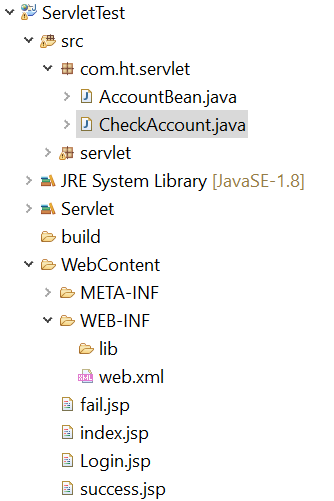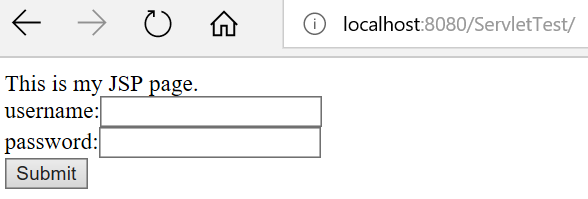前面两节已经学习了什么是Servlet,Servlet接口函数是哪些、怎么运行、Servlet生命周期是什么? 以及Servlet中的模式匹配URL,web.xml配置和HttpServlet。怎么在Eclipse中新建一个Servlet工程项目。 今天这里主要是创建一个Servlet+JSP的例子。
一、学习之前补充一下web.xml中配置问题
web.xml中<welcome-file-list>配置((web欢迎页、首页))
用于当用户在url中输入工程名称或者输入web容器url(如http://localhost:8080/)时直接跳转的页面.
welcome-file-list的工作原理是,按照welcome-file的.list一个一个去检查是否web目录下面存在这个文件,如果存在,继续下面的工作(或者跳转到index.html页面,或者配置有struts的,会直接struts的过滤工作).如上例,先去webcontent(这里是Eclipse的工程目录根目录)下是否真的存在index.html这个文件,如果不存在去找是否存在index.jsp这个文件,以此类推。
还要说的是welcome-file不一定是html或者jsp等文件,也可以是直接访问一个action。就像我上面配置的一样,但要注意的是,一定要在webcontent下面建立一个index.action的空文件,然后使用struts配置去跳转,不然web找不到index.action这个文件,会报404错误,
如果配置了servlet的url-pattern是/*,那么访问localhost:8080/会匹配到该servlet上,而不是匹配welcome-file-list;如果url-pattern是/(该servlet即为默认servlet),如果其他匹配模式都没有匹配到,则会匹配welcome-file-list。
例如:

FirstServlet.java
1 package servlet; 2 3 import java.io.IOException; 4 import java.io.PrintWriter; 5 6 import javax.servlet.ServletException; 7 import javax.servlet.annotation.WebServlet; 8 import javax.servlet.http.HttpServlet; 9 import javax.servlet.http.HttpServletRequest; 10 import javax.servlet.http.HttpServletResponse; 11 //@WebServlet("/Firstservlet") 12 public class FirstServlet extends HttpServlet { 13 14 /* (non-Javadoc) 15 * @see javax.servlet.http.HttpServlet#doGet(javax.servlet.http.HttpServletRequest, javax.servlet.http.HttpServletResponse) 16 */ 17 @Override 18 protected void doGet(HttpServletRequest req, HttpServletResponse resp) throws ServletException, IOException { 19 System.out.println("处理get()的请求。。。"); 20 PrintWriter pw = resp.getWriter(); 21 pw.write("hello!"); 22 } 23 24 /* (non-Javadoc) 25 * @see javax.servlet.http.HttpServlet#doPost(javax.servlet.http.HttpServletRequest, javax.servlet.http.HttpServletResponse) 26 */ 27 @Override 28 protected void doPost(HttpServletRequest req, HttpServletResponse resp) throws ServletException, IOException { 29 30 } 31 }
web.xml 配置
1 <?xml version="1.0" encoding="UTF-8"?> 2 <web-app xmlns:xsi="http://www.w3.org/2001/XMLSchema-instance" xmlns="http://java.sun.com/xml/ns/javaee" xsi:schemaLocation="http://java.sun.com/xml/ns/javaee http://java.sun.com/xml/ns/javaee/web-app_3_0.xsd" id="WebApp_ID" version="3.0"> 3 <display-name>ServletTest</display-name> 4 <welcome-file-list> 5 <welcome-file>index.html</welcome-file> 6 <welcome-file>index.htm</welcome-file> 7 <welcome-file>index.jsp</welcome-file> 8 <welcome-file>default.html</welcome-file> 9 <welcome-file>default.htm</welcome-file> 10 <welcome-file>default.jsp</welcome-file> 11 </welcome-file-list> 12 <servlet><servlet-name>ServletTest</servlet-name> 13 <servlet-class>servlet.FirstServlet</servlet-class> 14 </servlet> 15 <servlet-mapping> 16 <servlet-name>ServletTest</servlet-name> 17 <url-pattern>/*</url-pattern> 18 </servlet-mapping> 19 </web-app>
index.jsp
1 <%@ page language="java" contentType="text/html; charset=ISO-8859-1" 2 pageEncoding="ISO-8859-1"%> 3 <!DOCTYPE html PUBLIC "-//W3C//DTD HTML 4.01 Transitional//EN" "http://www.w3.org/TR/html4/loose.dtd"> 4 <html> 5 <head> 6 <meta http-equiv="Content-Type" content="text/html; charset=ISO-8859-1"> 7 <title>Insert title here</title> 8 </head> 9 <body> 10 <a href = "/ServletTest/FirstServlet">get this first servlet</a> 11 </body> 12 </html>
如果在上面web.xml里面配置<url-pattern>/*</url-pattern>, 在浏览器输入:直接匹配到Servlet

如果在上面web.xml里面配置<url-pattern>/</url-pattern>, 在浏览器输入:可以看出匹配到index.jsp

正常在web.xml里面配置<url-pattern>/FirstServlet</url-pattern>,会先匹配到index.jsp

二、Servlet+JSP
直接加例子:

1 package com.ht.servlet; 2 3 public class AccountBean { 4 private String username; 5 private String password; 6 /** 7 * @return the username 8 */ 9 public String getUsername() { 10 return username; 11 } 12 /** 13 * @param username the username to set 14 */ 15 public void setUsername(String username) { 16 this.username = username; 17 } 18 /** 19 * @return the password 20 */ 21 public String getPassword() { 22 return password; 23 } 24 /** 25 * @param password the password to set 26 */ 27 public void setPassword(String password) { 28 this.password = password; 29 } 30 } 31 32 package com.ht.servlet; 33 34 import java.io.IOException; 35 36 import javax.servlet.ServletException; 37 import javax.servlet.annotation.WebServlet; 38 import javax.servlet.http.HttpServlet; 39 import javax.servlet.http.HttpServletRequest; 40 import javax.servlet.http.HttpServletResponse; 41 import javax.servlet.http.HttpSession; 42 43 /** 44 * Servlet implementation class AccountBean 45 */ 46 @WebServlet("/CheckAccount") 47 public class CheckAccount extends HttpServlet { 48 private static final long serialVersionUID = 1L; 49 50 /** 51 * @see HttpServlet#HttpServlet() 52 */ 53 public CheckAccount() { 54 super(); 55 // TODO Auto-generated constructor stub 56 } 57 58 /** 59 * @see HttpServlet#doGet(HttpServletRequest request, HttpServletResponse response) 60 */ 61 protected void doGet(HttpServletRequest request, HttpServletResponse response) throws ServletException, IOException { 62 HttpSession sessionzxl = request.getSession(); 63 AccountBean account = new AccountBean(); 64 String username = request.getParameter("username"); 65 String pwd = request.getParameter("pwd"); 66 account.setPassword(pwd); 67 account.setUsername(username); 68 System.out.println("username :"+ username + " password :" + pwd); 69 if((username != null)&&(username.trim().equals("jspp"))) { 70 System.out.println("username is right!"); 71 if((pwd != null)&&(pwd.trim().equals("1"))) { 72 System.out.println("success"); 73 sessionzxl.setAttribute("account", account); 74 String login_suc = "success.jsp"; 75 response.sendRedirect(login_suc); 76 return; 77 } 78 } 79 System.out.println("fail!"); 80 String login_fail = "fail.jsp"; 81 response.sendRedirect(login_fail); 82 return; 83 } 84 85 /** 86 * @see HttpServlet#doPost(HttpServletRequest request, HttpServletResponse response) 87 */ 88 protected void doPost(HttpServletRequest request, HttpServletResponse response) throws ServletException, IOException { 89 90 doGet(request, response); 91 } 92 93 }
登录的jsp页面如下Login.jsp
1 <%@ page language="java" contentType="text/html; charset=ISO-8859-1" 2 pageEncoding="UTF-8"%> 3 <!DOCTYPE html PUBLIC "-//W3C//DTD HTML 4.01 Transitional//EN" "http://www.w3.org/TR/html4/loose.dtd"> 4 <% 5 String path = request.getContextPath(); 6 String basePath = request.getScheme()+"://"+request.getServerName()+":"+request.getServerPort()+path+"/"; 7 %> 8 9 <html> 10 <head> 11 <base href="<%=basePath%>"> 12 <meta http-equiv="Content-Type" content="text/html; charset=ISO-8859-1"> 13 <title>My JSP 'login.jsp' starting page</title> 14 </head> 15 <body> 16 This is my JSP page. <br> 17 <form action="login"> 18 username:<input type="text" name="username"><br> 19 password:<input type="password" name="pwd"><br> 20 <input type="submit" value="Submit"> 21 </form> 22 </body> 23 </html>
登录成功界面如下success.jsp:
1 <%@ page language="java" contentType="text/html; charset=ISO-8859-1" 2 pageEncoding="UTF-8"%> 3 <!DOCTYPE html PUBLIC "-//W3C//DTD HTML 4.01 Transitional//EN" "http://www.w3.org/TR/html4/loose.dtd"> 4 <%@ page import="com.ht.servlet.AccountBean"%> 5 6 <% 7 String path = request.getContextPath(); 8 String basePath = request.getScheme()+"://"+request.getServerName()+":"+request.getServerPort()+path+"/"; 9 %> 10 11 <html> 12 <head> 13 <base href="<%=basePath%>"> 14 <meta http-equiv="Content-Type" content="text/html; charset=ISO-8859-1"> 15 <title>My JSP 'success.jsp' starting page</title> 16 </head> 17 <body> 18 <%AccountBean account = (AccountBean)session.getAttribute("account");%> 19 username:<%= account.getUsername()%> <br> 20 password:<%= account.getPassword() %> <br> 21 basePath: <%=basePath%><br> 22 path:<%=path%><br> 23 </body> 24 </html>
登录失败的jsp页面如下:fail.jsp
1 <%@ page language="java" contentType="text/html; charset=ISO-8859-1" 2 pageEncoding="UTF-8"%> 3 <!DOCTYPE html PUBLIC "-//W3C//DTD HTML 4.01 Transitional//EN" "http://www.w3.org/TR/html4/loose.dtd"> 4 <% 5 String path = request.getContextPath(); 6 String basePath = request.getScheme()+"://"+request.getServerName()+":"+request.getServerPort()+path+"/"; 7 %> 8 9 <html> 10 <head> 11 <base href="<%=basePath%>"> 12 <meta http-equiv="Content-Type" content="text/html; charset=ISO-8859-1"> 13 <title>My JSP 'fail.jsp' starting page</title> 14 </head> 15 <body> 16 Login Failed! <br> 17 basePath: <%=basePath%><br> 18 path:<%=path%><br> 19 </body> 20 </html>
web.xml配置如下:
1 <?xml version="1.0" encoding="UTF-8"?> 2 <web-app xmlns:xsi="http://www.w3.org/2001/XMLSchema-instance" xmlns="http://java.sun.com/xml/ns/javaee" xsi:schemaLocation="http://java.sun.com/xml/ns/javaee http://java.sun.com/xml/ns/javaee/web-app_3_0.xsd" id="WebApp_ID" version="3.0"> 3 <display-name>ServletTest</display-name> 4 <welcome-file-list> 5 <welcome-file>Login.jsp</welcome-file> 6 </welcome-file-list> 7 8 <servlet> 9 <description>This is the description of my J2EE component</description> 10 <display-name>This is the display name of my J2EE component</display-name> 11 <servlet-name>CheckAccount</servlet-name> 12 <servlet-class>com.ht.servlet.CheckAccount</servlet-class> 13 </servlet> 14 <servlet-mapping> 15 <servlet-name>CheckAccount</servlet-name> 16 <url-pattern>/login</url-pattern> 17 </servlet-mapping> 18 </web-app>
描述一下上面运行过程:
在浏览器输入:http://localhost:8080/ServletTest/ 会通过欢迎页面welcome-file-list找到登录页面Login.jsp, 界面显示如下:

在登录页面输入用户名和密码,点击登录,找到对应的action, 会去运行/login其对应的servlet, 找到doGet()方法,判断用户名和密码
如果用户名密码不是jspp和1,就会跳转到失败页面fail.jsp

如果用户名等于jspp和1,则跳转到成功页面success.jsp

Session
上面就是一个最简单的JSP和servlet例子。在运行上面例子中,有一个概念session.
在checkAccount.java中,直接通过request获取session
HttpSession sessionzxl = request.getSession();
后面将定义的变量存储到session中:sessionzxl.setAttribute("account", account);
在jsp中怎么获取session?
在success.jsp中,有这么一行<%AccountBean account = (AccountBean)session.getAttribute("account");%>,那么session来至于哪儿?
查看资料后得知,session是jsp隐式对象。
JSP隐式对象是JSP容器为每个页面提供的Java对象,开发者可以直接使用它们而不用显式声明。JSP隐式对象也被称为预定义变量。
JSP所支持的九大隐式对象:
| 对象 | 描述 |
|---|---|
| request | HttpServletRequest 接口的实例 |
| response | HttpServletResponse 接口的实例 |
| out | JspWriter类的实例,用于把结果输出至网页上 |
| session | HttpSession类的实例 |
| application | ServletContext类的实例,与应用上下文有关 |
| config | ServletConfig类的实例 |
| pageContext | PageContext类的实例,提供对JSP页面所有对象以及命名空间的访问 |
| page | 类似于Java类中的this关键字 |
| Exception | Exception类的对象,代表发生错误的JSP页面中对应的异常对象 |
session是jsp的内置对象,所以你可以直接写在jsp的 <% session.setAttribute("a", b); //把b放到session里,命名为a, String M = session.getAttribute(“a”).toString(); //从session里把a拿出来,并赋值给M %>
下节添加一个Servlet+jsp+SQL例子。
https://blog.csdn.net/superit401/article/details/51974409